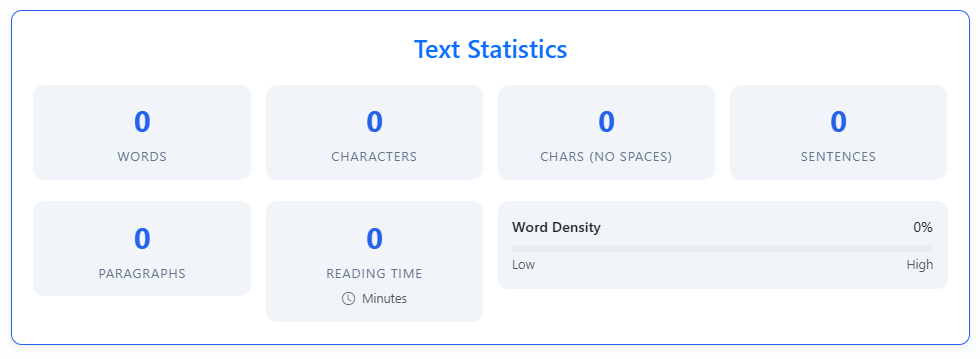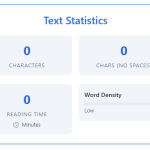Word Counting Secrets 2025 – Tips for Perfect Content Length
Introduction: Why Word Counting Still Matters in 2025

Table of Contents
In the age of AI-generated fluff and endless scrolling, one thing remains true: word count still matters. Whether you’re crafting blog posts, academic essays, social media content, or product descriptions—knowing exactly how many words you’ve written can mean the difference between success and silence.
Google favors long-form, informative content that matches search intent. Editors look for precise submission lengths. And platforms like Twitter and Instagram? They have hard character limits.
This article reveals:
- How to hit perfect counting for different formats
- Why character count matters just as much
- How tools like our Word Counting & Character Counting help you avoid over/underwriting
- Real stats and smart strategies trusted by professionals
Let’s break it down.
Section 1: What Is Word Count & Why It Matters
What Is Word Count?
Word/Character count is simply the number of words in a document or text. It helps define the scope, clarity, and length of your content.
Most platforms and industries use it as a basic content benchmark:
- Blog articles: 1,000–2,500 words (for SEO)
- College essays: 1,500–3,000 words
- LinkedIn posts: ~300 words
- Meta descriptions: ~150 characters
Real-World Impact
According to Semrush, long-form articles (over 3,000 words) get 3x more traffic, 4x more shares, and 3.5x more backlinks than short posts.
📌 Try this yourself with our Free Count Tool that shows both word and character length instantly.
Section 2: Word Count Benchmarks by Format
Blogging & SEO
- Ideal Word or Character Count for Google Ranking: 1,760 words (Backlinko, 2023)
- Top Ranking Pages: Average 1,447–2,500 words
Social Media
- Twitter/X: 280 characters
- Instagram Captions: Max 2,200 characters
- Facebook Posts: 40–80 words get the highest engagement
👉 Use our Character Counter Tool to tailor your posts.
Academic Writing
- Assignments: 1,500 to 3,000 words
- Research papers: 5,000+ words
🎓 Students use our tool to count words in Word documents and avoid penalty points for being too short or too long.
Section 3: Top 11 Word/Character Count Tips to Boost Quality & SEO
- Set a Target Before You Start
- Write Freely, Then Edit Ruthlessly
- Check Word & Character Count As You Go
- Use Subheadings (H2, H3) to Stay Structured
- Include Lists & Bullet Points for Readability
- Use Real Data to Add Depth
- Avoid Fluff – Prioritize Value per Word
- Use Our Counter tool for Precision
- Break Down Paragraphs (2–4 sentences each)
- Include Internal & External Links
- Use Visuals to Complement Text
Section 4: Character Count vs Word – What’s the Difference?
While word & character count helps gauge content size, character count matters for fields with hard limits (like meta descriptions or tweets).
| Metric | Purpose | Typical Limit |
|---|---|---|
| Word Count | SEO, readability | 1,000–2,500+ |
| Character Count | Metadata, ads, social posts | 150–2,200 |
Need both? Our free Word & Character Counter Tool gives you both in one place.
Section 5: How to Count Words in Microsoft Word or Google Docs
In Microsoft Word
- Go to Review > Word Count
- It also shows characters with/without spaces
In Google Docs
- Click Tools > Word Count
- Use
Ctrl+Shift+Cas a shortcut
But if you want a quick, browser-based solution, just paste your text into our Word or Character Count Tool.
Section 6: Use Cases for Writers, Marketers, and Developers
Content Writers & Bloggers
- Optimize article lengths for SEO
- Check blog descriptions for snippet display
Social Media Managers
- Stay within character limits for each platform
- Plan Instagram captions, tweets, etc.
Developers & UX Writers
- Fit copy into buttons, tooltips, app interfaces
💼 Want to build better UI? Use our Text Case Converter alongside word tools.
Section 7: Tools to Pair With Word/Character Count Checker
Section 8: External References & Trusted Stats
- Backlinko – Word/Char Count SEO Study
- Semrush – Long-Form Content Benefits
- Neil Patel – Blog Length Insights
What is the best word count for SEO in 2025?
Generally, SEO-friendly blog posts perform best when they are between 1,500 and 2,500 words, with long-form content (3,000+ words) performing even better for evergreen topics.
How do I count the words in Word or Google Docs?
In Word, go to Review > Word Count. In Google Docs, click Tools > Word Count or use the shortcut Ctrl+Shift+C.
What’s the difference between word count and character count?

Word count counts the number of words, while character count includes all letters, numbers, spaces, and punctuation. Character limits are especially relevant for metadata and social media.
Why is word count important in writing?
It helps ensure your content meets platform requirements, maintains reader attention, and matches search intent—all crucial for performance and engagement.
Is there a free tool to check both word and character count?
Yes! Use our Word & Character Counter Tool to measure both instantly.
Conclusion: Precision Is Power in the Digital Era
Whether you’re a professional writer, social media creator, or student—knowing your word and character count can change your content game. It’s not just about meeting limits—it’s about maximizing impact.
✅ Use our free Word & Character Counter
✅ Aim for the right length based on intent
✅ Combine precision with strong structure and formatting
Because in 2025 and beyond, content that’s the right length + right structure = better performance.
Ready to master content length? Try our full suite of tools designed for content creators, marketers, and digital professionals: Explore All Tools
